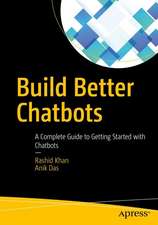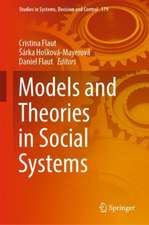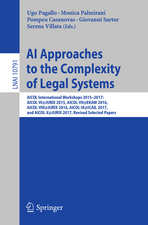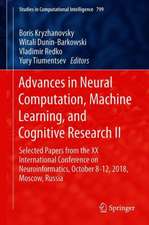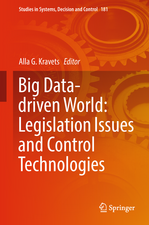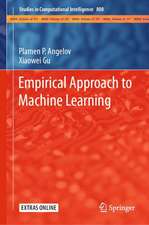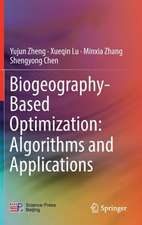Deep Learning for Natural Language Processing: Creating Neural Networks with Python
Autor Palash Goyal, Sumit Pandey, Karan Jainen Limba Engleză Paperback – 27 iun 2018
Discover the concepts of deep learning used for natural language processing (NLP), with full-fledged examples of neural network models such as recurrent neural networks, long short-term memory networks, and sequence-2-sequence models.
You’ll start by covering the mathematical prerequisites and the fundamentals of deep learning and NLP with practical examples. The first three chapters of the book cover the basics of NLP, starting with word-vector representation before moving onto advanced algorithms. The final chapters focus entirely on implementation, and deal with sophisticated architectures such as RNN, LSTM, and Seq2seq, using Python tools: TensorFlow, and Keras. Deep Learning for Natural Language Processing follows a progressive approach and combines all the knowledge you have gained to build a question-answer chatbot system.
What You Will Learn
- Gain the fundamentals of deep learning and its mathematical prerequisites
- Discover deep learning frameworks in Python
- Develop a chatbot
- Implement a research paper on sentiment classification
Who This Book Is For
Software developers who are curious to try out deep learning with NLP.
Preț: 322.40 lei
Preț vechi: 403.00 lei
-20% Nou
Puncte Express: 484
Preț estimativ în valută:
61.70€ • 64.18$ • 50.94£
61.70€ • 64.18$ • 50.94£
Carte disponibilă
Livrare economică 22 martie-05 aprilie
Preluare comenzi: 021 569.72.76
Specificații
ISBN-13: 9781484236840
ISBN-10: 148423684X
Pagini: 219
Ilustrații: XVII, 277 p. 99 illus., 2 illus. in color.
Dimensiuni: 155 x 235 x 19 mm
Greutate: 0.42 kg
Ediția:1st ed.
Editura: Apress
Colecția Apress
Locul publicării:Berkeley, CA, United States
ISBN-10: 148423684X
Pagini: 219
Ilustrații: XVII, 277 p. 99 illus., 2 illus. in color.
Dimensiuni: 155 x 235 x 19 mm
Greutate: 0.42 kg
Ediția:1st ed.
Editura: Apress
Colecția Apress
Locul publicării:Berkeley, CA, United States
Cuprins
Chapter 1: Introduction to NLP and Deep Learning.- Chapter 2: Word Vector representations.- Chapter 3: Unfolding Recurrent Neural Networks.- Chapter 4: Developing a Chatbot.- Chapter 5: Research Paper Implementation: Sentiment Classification.
Notă biografică
Palash Goyal works as Senior Data Scientist, and is currently working with the applications of Data Science and Deep Learning in Online Marketing domain.
He studied Mathematics and Computing from IIT-Guwahati, and proceeded to work in a fast, upscale environment.
He holds wide experience in E-Commerce, Travel, Insurance, and Banking industries.
Passionate about mathematics and Finance, in his free time he manages his portfolio of multiple Cryptocurrencies and latest ICOs using Deep Learning and Reinforcement Learning techniques for price prediction and portfolio management.
He keeps himself in touch with the latest trends in the Data Science field and pen it down on his personal blog and digs articles related to Smart Farming in left over time.
Sumit Pandey is a graduate from IIT Kharagpur. He worked for about a year with AXA Business services as a Data Science Consultant. He is currently engaged in launching his own venture.
Karan Jain is Product Analyst at Sigtuple , where he works on cutting edge AI driven diagnostic products .
Before which he worked as a Data Scientist at Vitrana Inc , a healthcare solutions company.
He enjoys working in fast culture and data-first start ups.
In his leisure time he deeps dive into Genomics sciences, BCI interfaces , Optogenetics .
He recently developed interest in POC devices and Nano tech for further portable diagnosis.
He has healthy network of 3000+ followers on linkedin.
Textul de pe ultima copertă
Discover the concepts of deep learning used for natural language processing (NLP), with full-fledged examples of neural network models such as recurrent neural networks, long short-term memory networks, and sequence-2-sequence models.
You’ll start by covering the mathematical prerequisites and the fundamentals of deep learning and NLP with practical examples. The first three chapters of the book cover the basics of NLP, starting with word-vector representation before moving onto advanced algorithms. The final chapters focus entirely on implementation, and deal with sophisticated architectures such as RNN, LSTM, and Seq2seq, using Python tools: TensorFlow, and Keras. Deep Learning for Natural Language Processing follows a progressive approach and combines all the knowledge you have gained to build a question-answer chatbot system.
This book is a good starting point for people who want to get started indeep learning for NLP. All the code presented in the book will be available in the form of IPython notebooks and scripts, which allow you to try out the examples and extend them in interesting ways.
You will:
- Gain the fundamentals of deep learning and its mathematical prerequisites
- Discover deep learning frameworks in Python
- Develop a chatbot
- Implement a research paper on sentiment classification
Caracteristici
Discover and develop your own deep learning networks by solving the puzzle of dropout, pooling, and normalization layers Get an exciting introduction to reinforcement learning and how to make use of context specific behavior Create your own chatbot using stacked bidirectional LSTM using Tensorflow and Keras


